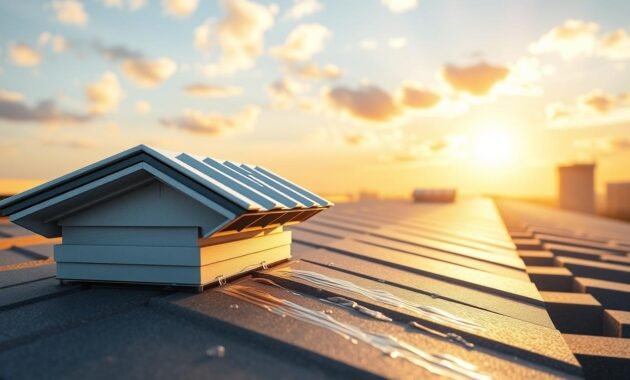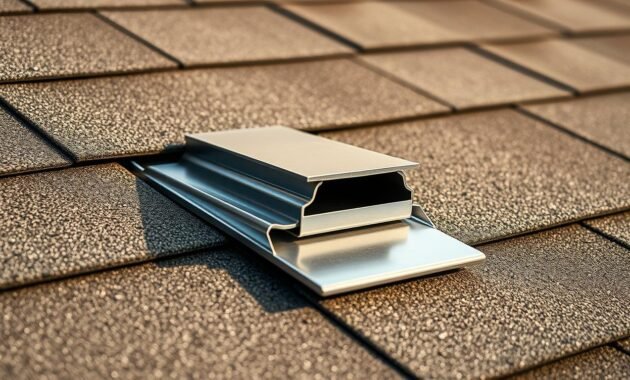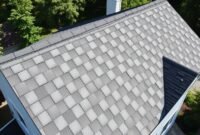A roof cricket is a hero for your home when water threatens. Many people don’t know about this important part of the roof. It’s a triangular piece that keeps water away from weak spots on your roof.
Water pooling and damage to roofs are common problems. Knowing about roof crickets can help avoid these issues. They work like a water diversion system, keeping water away from where it could leak.
Roof crickets are a smart way to manage water. They give homeowners peace of mind and protect their roofs for a long time.

Understanding Roof Crickets and Their Basic Function
Roof crickets are key to keeping your home’s roof safe. They tackle tough water drainage issues on steep roofs. Let’s explore how they work and why they’re vital for your roof’s health.
When building a roof deck, experts focus on managing water. Roof crickets form a triangular shape to stop water from gathering in bad spots. Their main job is to steer water away from weak spots in your roof.
Key Components of a Roof Cricket Structure
A roof cricket has a few important parts:
- Triangular wood frame base
- Waterproof membrane
- Angled design for optimal water flow
- Flashing integration
How Crickets Prevent Water Accumulation
Water pooling can harm your roof a lot. Roof crickets fix this by forming a peaked shape that moves water away. They’re great around chimneys, valleys, and other spots where water might gather.
Read also : What is Purlin Span for Metal Roof ?
The Evolution of Roofing Cricket Design
Roofing tech has grown a lot. Today’s roof crickets are more advanced, using better materials and design. Contractors use computers to make crickets that fit each home’s roof perfectly.
Knowing how to design roof crickets can make your roof last longer and save you from expensive water damage.
What is a Cricket in Roofing
A cricket in roofing is a special feature that helps with water drainage. It’s like a wedge or triangle on the roof that keeps water away. Roofers use crickets to manage water around tricky spots like chimneys and valleys.
Cricket design includes a slope to guide water flow. This helps water move around obstacles without pooling. Made from plywood, metal, or roofing materials, crickets are experts at diverting water.
- Prevents water accumulation behind chimneys
- Creates effective water runoff paths
- Reduces the risk of moisture damage
- Boosts roof drainage efficiency
Explaining crickets to homeowners, I say it’s like a small roof within a roof. Its job is to keep water away from trouble spots. Knowing about crickets can save you money on repairs in the future.
The Critical Role of Crickets in Chimney Protection
Keeping your roof safe from water damage is key, and chimney crickets are vital for this. The International Building Code has made it clear that chimneys need special protection. This is to stop water from causing harm.
Read also: How to Walk on Roof Tiles Safely without Damaging Them
A chimney cricket acts as a shield against water, stopping it from getting into your roof. It helps keep your roof safe from water damage. These special parts of your roof are made to keep water away from your chimney.
Building Code Requirements for Chimney Protection
The International Building Code now has rules for chimneys over 30 inches wide. These rules help keep your chimney safe and your roof strong. Some important things to remember include:
- Installing a cricket perpendicular to the roof slope
- Ensuring proper water diversion angles
- Using appropriate flashing materials
- Maintaining minimum slope requirements
Water Diversion Strategies
Keeping water away from chimneys needs careful planning. Chimney crickets help by creating a barrier that stops water from pooling. This prevents leaks and damage.
| Chimney Size | Cricket Requirement | Water Damage Risk |
|---|---|---|
| Under 30 inches | Optional | Low |
| Over 30 inches | Mandatory | High |
Preventing Structural Damage
Not having a chimney cricket can lead to big problems. Water can rot wood, grow mold, and damage your roof. Getting a good chimney cricket is a smart move for keeping your roof in good shape.
Materials Used in Cricket Construction
Choosing the right roofing material for roof cricket construction is key for lasting roof protection. Different materials have their own benefits based on your roofing needs and local weather.
Metal flashing is vital in roof cricket design. Roofers often suggest materials that can handle harsh weather and divert water well. The top roof cricket materials are:
- Copper: Very durable and naturally resistant to corrosion
- Galvanized steel: Affordable and strong
- Aluminum: Light and doesn’t rust
- Stainless steel: Most durable for tough environments
When picking roofing material for cricket construction, think about local weather, roof pitch, and budget. Copper is pricier but lasts longer. Galvanized steel is cheaper and works well too.
Roofers know that using the right metal flashing is key. It stops water from getting in, protects the roof, and makes your roof last longer.
Each material needs special installation. Working with skilled roofers means your roof cricket will be made with the best materials for your situation.
Read also: The Lowdown on Roofing Guarantees
Professional Installation Process and Techniques
Installing roof crickets needs precision and skill. As a pro roofer, I’ve found that it’s more than just measuring. It takes careful planning, special skills, and detail to fix roofs and manage water.
Experts use a detailed plan for roof cricket installation. This ensures it works well and lasts long.
Precise Measurement Techniques
The first step is to measure accurately. Roofing pros do this by:
- Measuring the chimney’s exact dimensions
- Calculating the right cricket pitch
- Determining the needed materials
- Checking the roof’s structure
Installation Best Practices
Here are some tips for installing crickets:
- Picking the right roofing materials
- Making a precise cricket template
- Ensuring water flows correctly
- Making it fit with the roof
- Using top-notch waterproof sealants
Quality Control Measures
Roof repair pros do quality checks during installation. They:
- Check the pitch and angle
- Verify sealant application
- Inspect material quality
- Test water flow and drainage
By using these methods, homeowners can get a strong and effective roof cricket. It keeps their property safe from water damage.
Benefits of Installing a Roof Cricket System

Installing a roof cricket system offers many benefits for homeowners. It greatly improves roof drainage, which is key around complex areas like chimneys and skylights.
Roof crickets do more than just manage water. They protect your roof from water damage by keeping moisture away from weak spots.
- Prevent water accumulation near critical roof penetrations
- Reduce possible structural damage risks
- Extend the roof’s lifespan
- Lessen the chance of leaks
Cricket systems help stop water from getting into your roof. They create paths for water to flow away from important areas.
| Benefit Category | Specific Advantage | Long-Term Impact |
|---|---|---|
| Water Management | Redirects moisture flow | Prevents structural deterioration |
| Structural Protection | Reduces water pooling | Extends roof durability |
| Maintenance Reduction | Minimizes repair needs | Lowers long-term maintenance costs |
Getting a roof cricket installed is a wise choice for your home. It helps manage water and keeps your roof in top shape, saving you from costly repairs.
Common Problems Solved by Roof Crickets
Roof crickets are unsung heroes in protecting your home. They prevent water damage and structural issues. These special roofing parts tackle critical challenges, saving homeowners from costly repairs and extending roof life.
Let me break down the key problems that roof crickets effectively solve:
Read also: Stone Coated Steel Roofing Problems
Water Pooling Prevention
Water pooling is a big threat to roof integrity. Roof crickets prevent pooling by creating slopes that guide water away. This stops water damage risks that can harm your home’s structure.
- Redirects water from flat or low-slope roof sections
- Creates optimal drainage pathways
- Reduces water accumulation around critical roof intersections
Debris Management Solutions
Roof crickets also manage debris. They create angles and slopes to stop leaves, branches, and other materials from collecting in bad spots.
| Debris Type | Risk Without Cricket | Cricket Solution |
|---|---|---|
| Leaves | Moisture retention | Improved water flow |
| Branches | Potential roof punctures | Easier removal |
| Pine Needles | Blockage of drainage | Enhanced drainage |
Extended Roof Lifespan Benefits
Roof crickets help extend your roof’s life by preventing water damage and debris buildup. Regular maintenance and proper installation can avoid early roof wear and save on repair costs.
- Reduces moisture-related structural damage
- Minimizes the risk of wood rot
- Protects roofing materials from prolonged water exposure
Maintenance and Care for Roof Crickets
Keeping roof crickets in good shape is key to protecting your home. Regular checks can stop expensive repairs and make your roof last longer. As a homeowner, I’ve found that taking care of your roof ahead of time is the best way to avoid big problems.
Good customer service from roofers starts with knowing how to maintain your roof. Here are the main steps to keep your roof crickets in great shape:
- Do visual checks twice a year
- Look for wear or damage signs
- Clear debris from around the cricket
- Check if sealant and flashing are good
When you’re doing roof cricket maintenance, focus on these important areas:
- Search for cracks or separation in the cricket
- Watch for water stains or moisture
- Check the roof materials around for damage
- Make sure water drains right
It’s wise to get professional roof checks every 3-5 years. While you can do some maintenance yourself, pros can catch issues you might miss. Getting regular expert inspections can save you a lot of money and keep your home safe.
Roof crickets are more than just a part of your roof. They’re your home’s first defense against water damage. Taking good care of them means your roof will stay watertight and work well for many years.
Cost Considerations and ROI
When planning roof repairs, knowing the cost of a roof cricket is key. The price can change a lot based on several important factors. Homeowners need to think about these carefully.
Roof cricket installation costs can range from $300 to $1,500. Most people spend about $750. Getting help from skilled roofing contractors can give you a precise estimate for your roof.
- Factors influencing roof cricket costs:
- Roof complexity and size
- Material selection
- Local labor rates
- Chimney or roof feature dimensions
Roof crickets offer a great return on investment. They stop water damage, saving you thousands in repairs. A good roof cricket can also make your roof last longer by keeping moisture away and avoiding structural problems.
Roofing experts say to think about long-term savings, not just the upfront cost. Even though it might seem expensive at first, the protection against water damage and structural repairs makes roof crickets a wise choice.
- Potential cost savings include:
- Preventing water damage
- Reducing possible structural repairs
- Extending roof lifespan
- Improving overall roof drainage
I suggest getting quotes from several good roofing companies. This way, you can find the best deal for your roof repairs. Look for quality customer service and clear pricing to find a reliable contractor.
Integration with Other Roofing Components
Roofing systems are complex networks of interconnected elements. They work together to protect your home from water damage. It’s important to understand how different components interact to maintain a strong and efficient roof deck.

Metal flashing is key in creating seamless protection across various roof surfaces. These waterproofing barriers connect different roofing components. They ensure water is directed away from vulnerable areas.
Flashing and Cricket Coordination
Roof crickets and metal flashing work together to prevent water infiltration. Their design helps manage water flow by:
- Creating directional slopes for efficient drainage
- Blocking water entry points
- Reinforcing critical junction areas
Drainage System Connection
Effective roofing drainage solutions rely on the connection between crickets, flashing, and the drainage system. This connection ensures water is quickly channeled away from the roof deck. This minimizes damage risks.
Professional roofers carefully plan these interactions. They aim to maximize water management and structural integrity. By understanding these connections, homeowners can see the sophisticated engineering behind modern roofing systems.
Seasonal Importance of Roof Crickets
Roof crickets are vital for protecting your home all year. They are key in areas with changing weather. They help stop water damage and keep your roof strong.
In rainy seasons, roof crickets keep water away from important roof spots. Their design lets water flow off easily, avoiding leaks and damage. Snow and ice in winter can also harm your roof.
- Spring: Helps manage melting snow and spring rainfall
- Summer: Provides protection during heavy thunderstorms
- Fall: Prevents leaf and debris buildup near roof intersections
- Winter: Supports snow and ice management
The roof’s slope is important for how well a cricket works. Steeper roofs drain water better, thanks to crickets. If you live where it rains a lot, check your cricket often.
Keeping your roof cricket in good shape is important. Check it during weather changes for damage or leaks. This can save you money on repairs and keep your roof lasting longer.
Conclusion
Knowing about roof crickets can really help protect your home. They keep water away from important spots like chimneys. This helps avoid costly repairs.
Roof crickets do more than just manage water. They are key to keeping your home strong. They help with drainage and prevent damage from moisture. They also stop water from pooling and keep debris away, making your roof last longer.
Getting roof crickets right can save you a lot of money. Whether you’re building or keeping up your home, a pro can guide you. They’ll help you find the best ways to keep water away.
As a homeowner, it’s smart to take care of your property. Roof crickets might seem small, but they’re vital. They help keep your home safe and sound. Don’t ignore them – they could save you from big water damage costs later.




